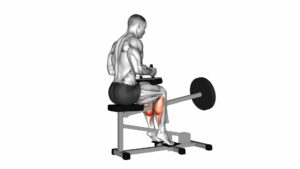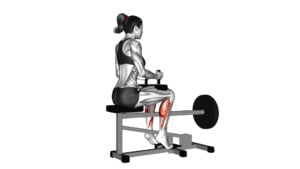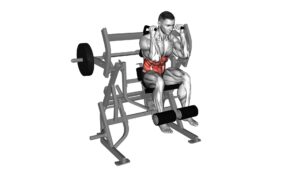Lever Seated Calf Raise (Plate Loaded) (Version 2) – Video Exercise Guide & Tips

Looking to strengthen your calf muscles? The Lever Seated Calf Raise (Plate Loaded) (Version 2) is the perfect exercise for you.
Watch This Exercise Video
In this video exercise guide, we'll show you the proper form and technique, as well as how to adjust the plate-loaded machine for maximum effectiveness.
We'll also cover variations, progressions, common mistakes to avoid, and provide tips for an effective calf workout.
Get ready to take your calf training to the next level with this informative guide.
Key Takeaways
- The lever seated calf raise targets and activates calf muscles effectively and efficiently.
- It helps in developing stronger and more defined calf muscles, enhancing the appearance of lower legs.
- The exercise improves athletic performance and strengthens the gastrocnemius and soleus muscles for walking, running, and jumping.
- It is important to maintain proper form and technique, with stable foot placement and controlled movements.
Benefits of the Lever Seated Calf Raise
You can experience several benefits when you incorporate the Lever Seated Calf Raise into your workout routine. This exercise specifically targets the muscles in your calves, activating them effectively and efficiently. By performing the Lever Seated Calf Raise, you can develop stronger and more defined calf muscles, which not only enhance the appearance of your lower legs but also contribute to improved athletic performance.
One of the key benefits of this exercise is its ability to activate and strengthen the gastrocnemius and soleus muscles in your calves. These muscles play a crucial role in various movements such as walking, running, and jumping. By regularly incorporating the Lever Seated Calf Raise into your routine, you can increase the strength and endurance of these muscles, allowing you to perform these activities with greater ease and efficiency.
Additionally, the Lever Seated Calf Raise is a compound exercise that engages multiple muscle groups in your lower legs. This means that not only are your calves being targeted, but other supporting muscles such as the tibialis anterior and the peroneus longus are also activated. Strengthening these muscles can improve your overall lower leg stability and balance.
In order to maximize the benefits of the Lever Seated Calf Raise, it's important to focus on proper form and technique.
Proper Form and Technique
To ensure proper form and technique while performing the Lever Seated Calf Raise, focus on maintaining a stable position with your feet securely placed on the foot platform. This exercise primarily targets your calf muscles, so it's important to activate them correctly.
Start by sitting on the machine with your knees bent at a 90-degree angle and your toes pointing forward. Place the balls of your feet on the foot platform, ensuring that your heels hang off the edge. This position allows for a greater range of motion and more effective calf muscle activation.
As you perform the exercise, focus on pushing through the balls of your feet and extending your ankles as far as possible. This will engage your calf muscles and provide a challenging workout. Keep your movements controlled and avoid using momentum to lift the weight. Maintaining proper form throughout the exercise is crucial to prevent muscle imbalances and reduce the risk of injury.
By following these guidelines, you can maximize the benefits of the Lever Seated Calf Raise and ensure that you're targeting the right muscles.
In the next section, we'll discuss how to adjust the plate-loaded machine for your individual needs.
Adjusting the Plate-Loaded Machine
To ensure proper adjustment of the plate-loaded machine for the Lever Seated Calf Raise, start by selecting the appropriate weight load. This exercise targets your calf muscles, so it's important to find the right weight to challenge yourself without compromising form.
Begin by sitting on the machine with your feet flat on the footrest and the balls of your feet on the lever platform. Adjust the machine height so that your knees are slightly bent and your heels can lower below the level of the footrest. This will allow for a full range of motion during the exercise.
Once the machine height is set, determine the weight load that's suitable for your fitness level. Start with a lighter weight and gradually increase it as you get stronger. Remember, it's better to start with a lighter weight and focus on maintaining proper form rather than using too much weight and risking injury.
Variations and Progressions
As you progress in your Lever Seated Calf Raise workout, you can explore different variations and progressions to continue challenging your calf muscles and further enhance your strength and stability.
One way to achieve progressive overload is by increasing the weight load on the machine. Gradually adding more weight as you become stronger will ensure that your muscles are continually challenged, leading to growth and development.
In addition to increasing the weight, you can also vary your foot positions to target different areas of your calf muscles. By placing your toes inwards, you'll emphasize the inner part of your calves, while pointing your toes outwards will target the outer calf muscles. This variation allows you to work the entire calf muscle group more effectively.
Another progression you can incorporate is performing the exercise on one leg at a time. This unilateral movement requires more stability and engages the muscles in a different way, providing a greater challenge. Start with lighter weights and gradually increase as you build strength and balance.
Remember to listen to your body and progress at a pace that's comfortable for you. By incorporating these variations and progressions into your Lever Seated Calf Raise workout, you'll continue to challenge your calf muscles and achieve greater strength and stability.
Common Mistakes to Avoid
When performing the lever seated calf raise, it's important to avoid common mistakes that can hinder your progress.
One common mistake is incorrect foot positioning, where your feet aren't properly aligned with the lever. This can lead to inefficient activation of the calf muscles.
Another mistake to avoid is insufficient range of motion, where you don't fully extend your ankles at the top of the movement. This limits the effectiveness of the exercise and reduces the potential gains in calf strength and size.
Incorrect Foot Positioning
Avoid improper foot positioning when performing the lever seated calf raise exercise. Proper foot placement is crucial for maximizing muscle activation and preventing injuries.
To ensure correct foot positioning, start by placing the balls of your feet on the edge of the foot platform, with your heels hanging off. Position your feet hip-width apart, keeping your toes pointing forward. This alignment allows for optimal engagement of the calf muscles.
Avoid placing your feet too close together or too far apart, as this can compromise stability and limit muscle activation. Additionally, avoid pointing your toes inward or outward, as it can place unnecessary stress on the ankles and compromise the exercise's effectiveness.
Insufficient Range of Motion
To maximize the effectiveness of the lever seated calf raise exercise, ensure that you perform a full range of motion with each repetition. Insufficient range of motion can limit the benefits of this exercise and hinder your progress. Here are some common range limitations and exercise modifications to consider:
- Lack of ankle flexibility: Stretch your calves and ankles before starting the exercise to improve your range of motion.
- Heavy weight: If you can't perform a full range of motion with the weight you're using, consider reducing the load to ensure proper form.
- Inadequate foot placement: Make sure your feet are positioned correctly on the footplate to allow for a full stretch and contraction of the calf muscles.
- Not going low enough: Lower the weight until your heels drop below the footplate to fully engage the calf muscles.
- Using momentum: Avoid using momentum to lift the weight. Instead, focus on controlled movements for maximum benefit.
By avoiding these range limitations and making necessary exercise modifications, you can ensure an effective calf workout.
Now, let's move on to some tips for optimizing your calf training.
Tips for an Effective Calf Workout
For a more effective calf workout, you can incorporate various exercises that target this muscle group. Calf muscle development is crucial for athletes as strong calves aid in explosive movements and enhance overall athletic performance. When planning your calf workout routine, consider exercises such as standing calf raises, seated calf raises, and calf presses on the leg press machine.
Standing calf raises involve lifting your body weight on the balls of your feet, while seated calf raises focus on isolating the calf muscles using a machine. Calf presses on the leg press machine allow you to increase the resistance and effectively target the calves. To further enhance your calf workout, you can also incorporate jump rope exercises, which engage the calves while improving cardiovascular fitness.
It's important to vary your calf exercises and gradually increase the intensity to continuously challenge your muscles and promote growth. Remember to warm up before your calf workout and stretch afterwards to prevent injuries and promote flexibility.
Frequently Asked Questions
How Much Weight Should I Start With When Using the Lever Seated Calf Raise Machine?
When starting with the lever seated calf raise machine, it's important to choose an appropriate starting weight. Consider your fitness level and calf strength. Begin with a weight that allows you to perform the exercise with proper form and control.
Additionally, pay attention to your knee position during the exercise to avoid any strain or discomfort. Gradually increase the weight as you build strength and feel more comfortable with the exercise.
Is It Necessary to Keep My Knees Straight During the Exercise?
When performing the lever seated calf raise exercise, it's important to keep your knees straight. This helps to target the calf muscles more effectively and prevent strain on the knees. By keeping your knees straight, you can ensure proper form and maximize the benefits of this exercise.
Incorporating the lever seated calf raise into your leg workout routine can help strengthen and tone your calves, improving your overall lower body strength and stability.
Can I Perform the Lever Seated Calf Raise Exercise Without Using a Plate-Loaded Machine?
Yes, you can perform the lever seated calf raise exercise without using a plate-loaded machine. There are alternative methods that can be used, such as using dumbbells or a resistance band to provide the necessary weight.
Performing this exercise helps to strengthen and tone your calf muscles, improving stability and balance. It also helps to increase ankle mobility and can be beneficial for athletes who require explosive power in their lower legs.
How Often Should I Incorporate the Lever Seated Calf Raise Into My Workout Routine?
To determine the incorporation frequency of the lever seated calf raise into your workout routine, consider your overall calf development goals and training schedule.
It's important to maintain proper form throughout each repetition to maximize effectiveness and minimize the risk of injury.
Consult with a fitness professional or trainer to assess your specific needs and create a tailored plan.
Are There Any Specific Calf Stretches or Warm-Up Exercises I Should Do Before Performing the Lever Seated Calf Raise?
Before performing the lever seated calf raise, it's important to do calf stretches and warm-up exercises. Calf stretches help to improve flexibility and prevent injury. You can try standing calf stretches or seated calf stretches to target the muscles effectively.
Additionally, performing warm-up exercises such as calf raises or ankle circles can help increase blood flow and prepare your muscles for the exercise.
Incorporating these stretches and warm-up exercises into your routine can enhance the effectiveness of the lever seated calf raise.
Conclusion
In conclusion, the lever seated calf raise (plate loaded) is an effective exercise for targeting and strengthening the calf muscles. By using proper form and technique, adjusting the plate-loaded machine, and incorporating variations and progressions, individuals can maximize the benefits of this exercise.
It's important to avoid common mistakes and follow tips for an effective calf workout to ensure optimal results. Incorporating the lever seated calf raise into your fitness routine can help improve calf strength and overall lower body performance.

Author
Years ago, the spark of my life’s passion ignited in my mind the moment I stepped into the local gym for the first time. The inaugural bead of perspiration, the initial endeavor, the very first surge of endorphins, and a sense of pride that washed over me post-workout marked the beginning of my deep-seated interest in strength sports, fitness, and sports nutrition. This very curiosity blossomed rapidly into a profound fascination, propelling me to earn a Master’s degree in Physical Education from the Academy of Physical Education in Krakow, followed by a Sports Manager diploma from the Jagiellonian University. My journey of growth led me to gain more specialized qualifications, such as being a certified personal trainer with a focus on sports dietetics, a lifeguard, and an instructor for wellness and corrective gymnastics. Theoretical knowledge paired seamlessly with practical experience, reinforcing my belief that the transformation of individuals under my guidance was also a reflection of my personal growth. This belief holds true even today. Each day, I strive to push the boundaries and explore new realms. These realms gently elevate me to greater heights. The unique combination of passion for my field and the continuous quest for growth fuels my drive to break new ground.







